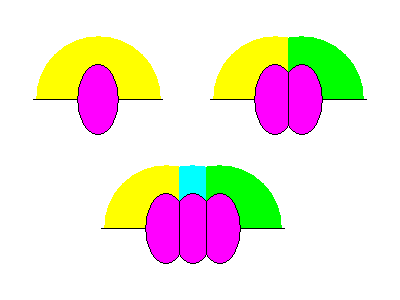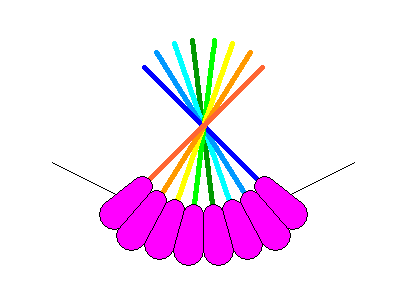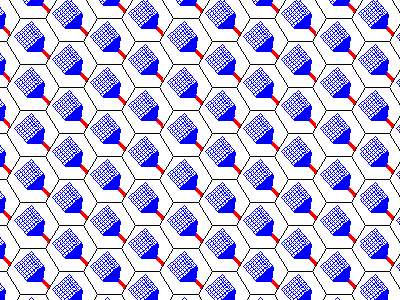What Good is Half a Wing?
Steven Dutch, Natural and Applied Sciences, Universityof Wisconsin - Green Bay
First-time Visitors: Please visit Site Map and Disclaimer. Use"Back" to return here.
One of the most common criticisms of evolution is the question "whatgood is half a wing?" Anti-evolutionists point out that organs must befunctional at every stage of evolution, otherwise they wouldn't be selected, andtherefore half-formed wings, eyes, and lungs are impossible.
This is, in fact, a valuable insight that tends to get lost in many simple discussions of evolution, so it's small wonder that creationists are puzzled. The reality is there are no half-evolved organisms. Every organism is fully adapted to its environment all the time, assuming the environment is stable. When the environment changes, then it's a whole new ball game and natural selection does its thing. In fact, you can gain valuable insights into how evolution must have happened by requiring that at every step, organisms must be fully functional. You can easily show that some popular stereotypes, for example, lungfish crawling out of drying ponds onto the land, just can't work. Instead, early amphibians had fully developed limbs, developed for locomotion, sensing in murky environments, maybe even clasping during mating, while they were still completely aquatic.
One problem with the half-a-wing criticism is that it ignores exaptation, theadaptation of a trait originally developed for one function to some otherfunction. But apart from exaptation, the half-a-wing criticism is completely false.
Actually, half-formed eyes and wings can be very useful. Any light-detecting ability, however rudimentary, will enable an organism to seek shelter, find food, and avoid predators. Similarly, half-formed wings aren’t as useless as often imagined. The idea that eyes and wings can only function if fully formed is completely false. Indeed, it’s a lot easier to see how partial versions of these organs could function than it is for many other organs. Creationists assume that problems in evolution are insolublewithout making even the slightest attempt to see if solutions exist.
Flying
The key to wings is surface-volume ratio. Body mass and volume increase as the cube of size, so that an adult rabbit 10 times as long as a newborn will weight 10x10x10 or 1000 times as much. On the other hand, bone strength increases as the cross-sectional area of the bone, or as the square of size. Thus, an elephant 10 times as tall as a dog will have 1000 times the body mass, and need 1000 times as much bone strength. Its bones will have to be 31.6 times as big in diameter as the dog’s (31.6 x 31.6 = 1000). Thus the elephant’s bones will be much thicker in proportion to their length than the dog’s. Conversely, a mouse 1/10 as large as the dog has to support only 1/1000 as much mass and needs only 1/1000 as much bone strength, so mouse bones are much thinner than dog bones in proportion to their size. Bone proportion is why a snapping mousetrap is painful for a human but fatal for a mouse. A dog, a mouse, and an elephant all scaled to the same size would look quite different and it would be immediately obvious which is which.
If we apply these scaling laws to humans, an adult three times the size of a baby would weigh 3 x 3 x 3 = 27 times as much. A typical baby is about 55 cm (22 inches) long, an adult 165 cm (67 inches) tall. If the baby weighs 3 kg (6.6 pounds) we'd expect the adult to weigh 81 kg (178 pounds). That's a bit on the heavy side for a 165-cm human, because babies are chunkier than adults. That's partly why they're cute.
Now, air resistance is related to surface area and varies as the square of size. Objects falling through the air eventually reach a terminal velocity (for skydivers it is about 200 km/hr.) As organisms get smaller, their mass goes down as the cube of their size but air resistance as the square. Thus, a rat 1/10 as big as a human has 1/1000 the mass, but 1/100 the air resistance. In other words, in proportion to its size, a rat encounters ten times as much air resistance. Small organisms encounter such large air resistance that they can easily survive a fall that would kill a human.
Surface-volume ratio explains why flying birds cannot be very large. Mass goes up as the cube of size, but lift, which is related to wing area, goes up only as the square of size. So does bone strength to support the wings and muscle cross-section to power them. So a big bird compensates for its large body mass with larger wings, thicker bones, and thicker muscles, and a much greater tendency to glide. Big birds like condors with 4-meter wing spans are near the limit of size for birds, and they have far larger wing spans in proportion to their size than sparrows. During the Mesozoic there were flying reptiles with bigger wing spans. We have complete fossils of flying reptiles with 7-meter wing spans and partial fossils of creatures that may have had wing spans of 15 meters or more. We’re not sure how much powered flight capability they had, or whether they were solely gliders, and the bodies that have been found are about the size of the largest flying birds today. They could surely not have carried off a human, as the flyingreptiles of Jurassic Park III or Dinotopia did.
In addition to birds, bats, and insects, the three groups that have true powered flight, organisms that glide include squirrels, lemurs, marsupials, lizards, frogs, snakes, and fish. Flying snakes simply launch from a tree and let air resistance do most of the work. The others all have some modified body part to help with gliding. Squirrels and lizards have loose skin flaps, frogs have outsized webbed feet, and fish have oversized fins. All are small. All the terrestrial animals could survive a fall from a tree without serious harm even without gliding apparatus. What the gliding apparatus does is increase duration and improve control.
Although we don’t know all the details, it’s not hard to picture a primitive insect, bird or bat starting out with partial wings that enhance gliding capability. Anything, however rudimentary, that improves duration or control, will help the organism survive.
Australian reader Paul Norris pointed out that even on the ground, wings can have strong evolutionary advantages. They can serve as displays, to startle attackers or attract mates. They can serve for thermoregulation, either trapping heat against the body or serving as radiators when extended. Many biologists are convinced feathers evolved first for insulation and were only modified later for flight. And they provide enhanced maneuverability when running. They can provide stability and cornering ability, as well as greater leaping ability. Try catching a chicken sometime for a demonstration. Maybe Archaeopteryx was something like a road runner.
"Bumblebees Can't Fly"
This is a good place to dismiss a couple of venerable myths about bumblebees.Supposedly, somebody once "proved" that bumblebees can't fly. Thisincident supposedly proves the inadequacy of scientific theory and theincompetence of scientists. What it proves is the credulity of non-scientists.
Bumblebees can't glide, at least not very far. But neither can a lotof high performance jet fighters. (Or even propeller craft. Old flying joke: the propeller is a giant fan to keep the pilot cool. Turn it off, and watch him start to sweat.) If you supply enough power, you can make abrick fly. And that's how bumblebees and jet fighters fly - brute force. It's actually a loteasier for the bumblebee (surface to volume ratio, again). By the way, thebumblebee didn't evolve from some non-flying ancestor, but from other kinds ofbees.
Many small birds don't glide well, either. Goldfinches are noted for theirundulating flight. Watch closely and it's obvious that the finch fires off a fewpower strokes, stops flapping and arcs up into a ballistic path, then repeatsthe process. If a goldfinch had a very good glide ratio (horizontal glide versusvertical drop) it wouldn't need to "go ballistic." Flying is about themost energy intensive thing there is - hummingbirds spend their lives runningOlympic marathons or swimming the English Channel - and any energy-savingtechnique is a boon.
Another cherished myth is that a bumblebee can carry more than its ownweight, something no aircraft can do. The problem with this myth is that (a) itignores surface-volume effects again and (b) it's just plain (plane) wrong. TheC-130 transport had an empty weight of 76,780 pounds and a maximum takeoffweight of 175,000 pounds. A C-5 Galaxy has a maximum takeoff weight in wartimeof 840,000 pounds, a full fuel load of 332,500 pounds and a maximum cargo loadof 270,000 pounds. That means the empty weight of the plane is 840,000 - 332,500- 270,000 = 237,500 pounds. In other words the plane weighs only 1/3 of itsfully loaded weight. Put in 30,000 pounds of fuel and the payload would exceedthe weight of the plane plus fuel. You wouldn't get very far but thenagain bumblebees need a lot of fuel too. Bumblebees actually have an advantagebecause they're not expected to fly long distances nonstop.
Half an Eye
Even some single-celled organisms have eyespots that enable them to respondto light. An organism with a small light-receptor patch would sense only lightand dark. But if the patch becomes a little larger, interesting things happen.
 | Unless the patch is perfectly flat, different cells will face in slightly different directions, and receive slightly different light signals. Now it becomes possible to discriminate differences in light direction. Sudden changes in intensity may signal the approach of a predator. So an organism with even a crude directional imaging capability could have a big advantage. We can expect natural selection to favor two traits:
Even if the receptor cell is totally non-directional, it will still only sense light from a certain field of view. Light from behind and from the side will be blocked by neighboring cells. So any array of receptors will have somecrude imaging capability, provided the brain processes the signals appropriately. Brains that ignore this source of survival data will get eaten. |
 | Directional capability can be achieved two ways: by bulging the receptor array outward or making it concave inward. Insects and other arthropods adopted the outward approach. |
 | Vertebrates, as well as advanced mollusks like the squid and octopus, went for the concave-in design. Concave in has the advantage of protecting the receptors, plus an additional benefit. If the concavity becomes really deep, theopening acts more and more like the lens of a pinhole camera. Not only do the receptors have wide directional orientations, but the lip of the opening aids detection by blocking light from certain directions. Natural selection would favor not only a deeper concavity, but actually a narrowing of the opening. Half an eye, with only a spherical cavity lined with cells plus a small opening,would be a quite good imaging system. |
 | This is a good place to debunk the myth that insects have thousands of eyes and see myriad images. |
 | Each eye facet is more like a fiber optic filament, channeling light to the receptors. So, to the extent we can imagine what an insect "sees," it is probably more like a coarsely pixelated image on a TV screen rather than the multiple overlapping images somany popular books and educational shows like to portray. |
Vision has a price. Something like 20 per cent of our energy goes to run ourbrains, and in humans, half of that goes to vision. So in an environment wherevision is unnecessary, it's a huge energy drain. Light-poor environments arealso likely to be nutrient-poor as well. So in these environments, naturalselection will not favor vision, except maybe for crude sensors to tell when theorganism is approaching the surface. Earthworms don't have eyes. Many cave fish,insects, and naked mole rats (probably the most grotesque mammals imaginable)also lost their eyes.
Half a Lung
The problem with lungs is passing gases through a membrane, something biologyis very good at. Most aquatic organisms have pretty low oxygen demands andrequire only crude apparatus - gills. Indeed, many organisms, including somefish and even amphibians, get oxygen through their skins. Fish have air bladdersfor buoyancy, and obviously these can readily be exapted for oxygen exchange aswell. All that's needed is to make the membrane thin or permeable enough to passgases, plus blood flow to the membrane to transport gases. It's common to see fish in oxygen-poor water taking in air through theirmouths to supplement their gills. Bettas - Siamese fighting fish - are a goodexample of fish that have air-breathing sacs in addition to gills.
(My father raised bettas for some years. Common wisdom is that males fightand females get along peacefully, but we saw every combination and permutationimaginable. We had males that shared a tank like drinking buddies and femalesthat fought.)
So for aquatic organisms, moving onto land is not that big a deal. A landedfish gasping for air is getting some, but will eventually die as his gillsdehydrate, plus his muscles to pump water over his gills don't do the job inair. (You'd face a similar problem in water. Your lungs could extract enoughoxygen from the water, but your diaphragm would tire after only a couple ofbreaths.) Numerous land-dwelling organisms, particularly arthropods, breathe withgills, but they stick to wet environments and have protections for the gills indry settings. Many amphibians not only get air from lungs, but also throughtheir skins.
From the standpoint of physics, then, moving from water to land is not agreat obstacle. By the way, amphibians did not crawl out of the sea. All theevidence is that they evolved in fresh water, originally developing limbs forlocomotion in water rather than on land.
The real problem is not getting oxygen on land but moving to a dryenvironment. But the great advantage faced by organisms that could cope withdrier environments was huge - no competitors whatsoever, so natural selectionwould favor organisms that could make the transition, even marginally, in a bigway. An organism that could spend most of its time in a dry setting and onlycome to wet areas to feed would essentially be immune to predation. There wouldbe a need for lungs, but we have fish with air sacs that double as oxygenintakes and fish with true lungs, so all the hardware existed before anyorganism set foot on land. And this hardware initially supplemented gills, sohalf a lung was perfectly functional.
Return to Pseudoscience Index
Return to Professor Dutch's Home Page
Created 8 January 2002, Last Update 24 May, 2020
Not an official UW Green Bay site